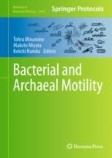Search
Search Results
-
Metabolite Analyses Using Nuclear Magnetic Resonance (NMR) Spectroscopy in Plasma of Patients with Prostate Cancer
Nuclear magnetic resonance (NMR) spectroscopy enables the detection and the quantification of a large range of molecules, including...
-
Solution-state nuclear magnetic resonance spectroscopy of crystalline cellulosic materials using a direct dissolution ionic liquid electrolyte
Owing to its high sustainable production capacity, cellulose represents a valuable feedstock for the development of more sustainable alternatives to...

-
Nuclear Magnetic Resonance Spectroscopy to Analyse Protein Folding and Dynamics
Proteins are nanoscale machines that perform all the work in living systems. Their function depends on their three-dimensional (3D) structure. These...
-
Detecting and Characterizing Interactions of Metabolites with Proteins by Saturation Transfer Difference Nuclear Magnetic Resonance (STD NMR) Spectroscopy
Saturation transfer difference (STD) nuclear magnetic resonance (NMR) spectroscopy is an established technique for detecting and characterizing the...
-

-
Site-Specific Isotope Labeling of FliG for Studying Structural Dynamics Using Nuclear Magnetic Resonance Spectroscopy
To understand flagella-driven motility of bacteria, it is important to understand the structure and dynamics of the flagellar motor machinery. We...
-

-
The Complementarity of Nuclear Magnetic Resonance and Native Mass Spectrometry in Probing Protein-Protein Interactions
Nuclear magnetic resonance (NMR) and native mass spectrometry (MS) are mature physicochemical techniques with long histories and important...
-
Magnetic nanoparticles in the body parts of Polistes versicolor and Polybia paulista wasps are biomineralized: evidence from magnetization measurements and ferromagnetic resonance spectroscopy
The detection of the geomagnetic field by animals to use as a cue in homing and migration is known as magnetoreception. The ferromagnetic hypothesis...

-
Metabolomics Analysis of Urinary Extracellular Vesicles by Nuclear Magnetic Resonance and Liquid Chromatography–Mass Spectrometry
Extracellular vesicle (EV) release and their content are influenced by diverse clinical conditions. EVs participate in inter-cellular communication...
-
Nuclear Magnetic Resonance Spectroscopy in Food Analysis
Nuclear magnetic resonance (NMR) spectroscopy is a powerful spectroscopic technique, conventionally used for structure verification, elucidation, and...
-
Probing Substrate-Loaded Carrier Proteins by Nuclear Magnetic Resonance
Carrier proteins (CPs) are central actors in nonribosomal peptide synthetases (NRPSs) as they interact with all catalytic domains, and because they...
-
Application of electron paramagnetic resonance spectroscopy for determining the relative nanoenvironment fluidity of polymeric micelles
AbstractPolymeric micelles are nanocarriers for drug, protein and gene delivery due to their unique core/shell structure, which encapsulates and...

-
Type I Lipoteichoic Acid (LTA) Purification by Hydrophobic Interaction Chromatography and Structural Analysis by 2D Nuclear Magnetic Resonance (NMR) Spectroscopy
Type I lipoteichoic acid (LTA) is a glycerol phosphate polymer found in the cell envelope of diverse Gram-positive bacteria. The glycerol phosphate...
-
Nuclear Magnetic Resonance Methods in Structural Characterization of Glycosaminoglycans
Glycosaminoglycans (GAGs) are sulfated glycans of complex structure and multiple biological actions. They are composed of disaccharide repeating...
-
Bone marrow plasma metabonomics of idiopathic acquired aplastic anemia patients using 1H nuclear magnetic resonance spectroscopy
IntroductionIdiopathic acquired aplastic anemia (AA) is a bone marrow failure disorder where aberrant T-cell functions lead to depletion of...

-
Linewidth, field, and frequency in electron paramagnetic resonance (EPR) spectroscopy
EPR spectroscopy requires a combination of fixed microwave radiation and resonant external magnetic field. Bigger is not necessarily better in that...

-
Structural Analysis of Proteins from Bacterial Secretion Systems and Their Assemblies by NMR Spectroscopy
Bacterial secretion systems are built up from proteins with different physicochemical characteristics, such as highly hydrophobic transmembrane...
-
Feasibility of Non-invasive Measurement of Tumour NAD(H) by In Vivo Phosphorus-31 Magnetic Resonance Spectroscopy
Importance of the redox status of nicotinamide adenine dinucleotide (NAD), including its oxidized (NAD+) and reduced (NADH) forms, has been shown in...
-
Mathematical Study of the Perturbation of Magnetic Fields Caused by Erythrocytes
The purpose of this chapter is the mathematical study of the perturbation of a homogeneous static magnetic field caused by the embedding of a red...
